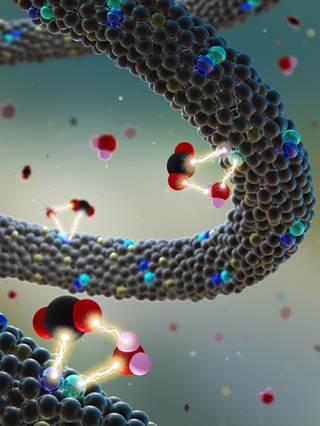In a collaborative project led by Prof. Chen Chen (Tsinghua University), Prof. Xiao Hai (Tsinghua University) and Associate prof. Lirong Zheng (Institute of High Energy Physics, Chinese Academy of Sciences), the research team developed a novel nanocatalyst featuring “Cu10–Cu1x+ atom pair” active sites by utilizing the surface defects on alloy nanowires. The result was published published on Nature Chemistry (Nature Chemistry, 11, 222–228, 2019). Under relatively low overpotentials, this atom-pair-bearing catalyst, in contrast to single-atomic catalysts, gave a faradaic efficiency for CO (FECO) as high as 92%, manifesting a high selectivity and well suppressed competing reactions (typically, hydrogen evolution reaction). The team constructed a set of in-situ Operando XAFS instruments at 1W1B-XAFS experimental station of BSRF, and investigated the interaction between active sites and adsorbed reactant molecules at the solid–liquid interface between the nanocatalyst and the electrolyte, as well as the dynamic evolution of the atomic structures of the active centers after the application of external electrical field. In this project, synchrotron radiation instrument helped the scientists to probe into the microscopic structures of nanocatalysts and to unravel the mystery of high-efficiency active sites. Facilitated by the powerful XAFS-related technologies, the scientists confirmed the high efficiency of “double-center active sites” for electrocatalysis, and unveiled the real status of the “double-center active sites” under working conditions.

Fig:The Schematic diagram of constructing “Atom-pair” Catalytic Sites by Utilizing Surface Defects on Alloy Nanowires.
Article:
Jiqing Jiao, Rui Lin, Shoujie Liu, Weng-Chon Cheong, Chao Zhang, Zheng Chen, Yuan Pan,Jianguo Tang, Konglin Wu, Sung-Fu Hung, Hao Ming Chen, Lirong Zheng, Qi Lu, Xuan Yang7,Bingjun Xu7, Hai Xiao*, Jun Li, Dingsheng Wang, Qing Peng, Chen Chen* and Yadong Li , Copper atom-pair catalyst anchored on alloy nanowires for selective and efficient electrochemical reduction of CO2. Nature Chemistry, 11, 222–228, 2019.


